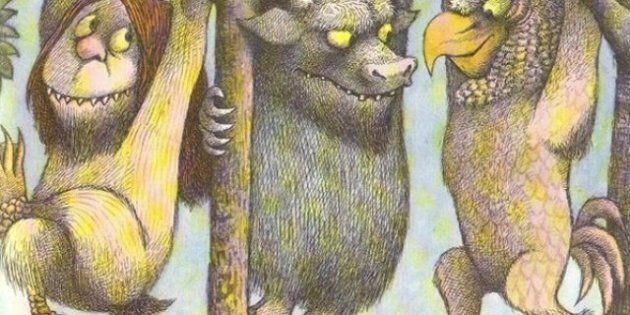
One day in the 1970s, when I was in my early 20s, I was sitting in a friend's apartment in Montreal, in the throes of a very intense LSD trip, and talking, probably rather incoherently, about the emotional journeys that we take to confront our inner psychological demons.
My friend, an education student, said, "Here, tell me what you think of this," and handed me a children's book called Where the Wild Things Are.
If you're an adult reading this post, you have probably already read Where the Wild Things Are, and this essay has no intention of promoting the use of illegal and powerful psychotropic drugs. However, the fact is that there may be less rewarding ways of being introduced to Maurice Sendak's masterpiece than as an adult on acid.
The book was instantly entrancing on many levels. Of course, it still is. There are the immediately recognizable Wild Things, with their uncanny resemblance to scary old people perceived through the eyes of childhood (Sendak based them on his Jewish relatives).
There is the complicated identity of Max as a wild thing himself, and his subsequent confrontation with the Wild Things within him. There is the ingenious formatting of the book, with its subtly expanding pictures, beginning within sedate margins beside polite words, and gradually growing to take over two-page spreads as the celebratory rumpus of King Max and the Wild Things casts its loud, silent, wordless spell.
There is the strange conflation of time, in which Max travels for years to the land of the Wild Things and back, to find his supper waiting for him, still hot. And there is the heroic myth at the heart of the story: the epic journey, the courageous confrontation, and the ultimate renunciation of power in favour of the love waiting at home.
Where the Wild Things Are was enormously controversial when it was first published. As Sendak said to James Still in an interview published in Theatre for Young Audiences: 20 Great Plays for Children,
"It was a very rocky time for me...Wild Things seemed to just rock the boat so dangerously...I was afraid I'd gone too far out on a limb. I'd been a 'good boy' until then. I'd done books that the librarians applauded... Where the Wild Things Are was way out of line, and the establishment -- and I'm speaking generally, many librarians and colleagues applauded my effort but many did not -- they felt that they had been betrayed by me... I had betrayed them with this ugly book."
But as the years went by, and the children responded, Where the Wild Things Are gradually took on the status of a classic.
The book is now required reading in my university course in Theatre for Young Audiences. Many of my students have intense stories of their own first encounters with it in childhood. We also discuss Sendak's many other accomplishments. His Outside Over There looks like a book by Mozart, if Mozart had drawn and written children's books. His In the Night Kitchen created its own controversy with its proud, explicitly naked baby hero. His sets for operas and ballets have revolutionised the art of theatre design. His smaller books, and illustrations for other writers' books, have introduced a delightful, mysterious style in which pictures, dialogue and narration can travel along in parallel lines, often telling three stories at once.
But perhaps his greatest achievement was virtually to transform the art of children's literature, sweeping away the sentimentality and falsehood that clutter so many books for kids, and returning to the truthfulness and bracing power of ancient fairy tales.
The controversial psychologist Bruno Bettelheim wrote, in the introduction to his The Uses of Enchantment: The Meaning and Importance of Fairy Tales, "The child must be helped to make some coherent sense out of the turmoil of his feelings...The child finds this kind of meaning through fairy tales."
In Where the Wild Things Are, Sendak created a modern fairy tale that has made sense of the inner world of recent generations of children.